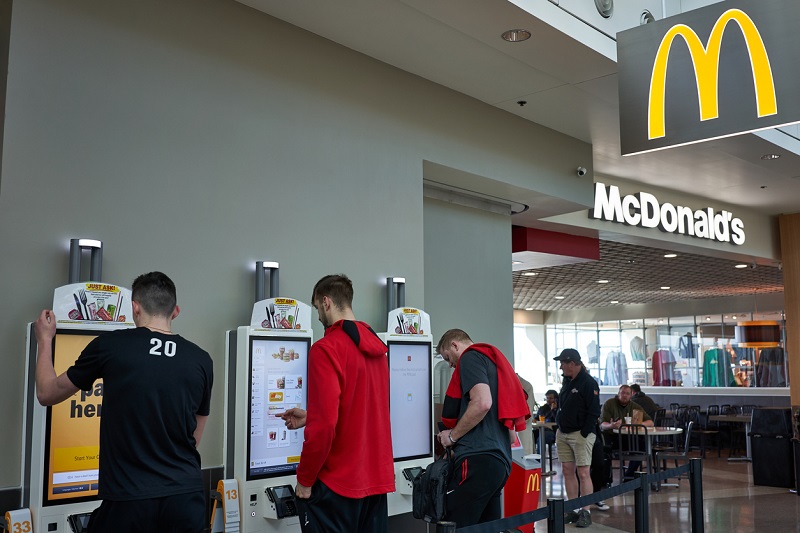A digital kiosk system is made up of multiple parts, including the kiosk enclosure, the software, and the various components and integrations that enable the kiosk to function as intended. This article will describe all parts of the kiosk system and how industries utilize them to assist with their customer needs.
Parts of a Self-Service Kiosk System
Kiosks are comprised of what we sometimes refer to as “the body,” “the brain,” and “the heart.”
The body of the kiosk is the enclosure that holds the display, and protects the inner workings and keeps them secure.
The brain of the kiosk is the software -- the smartest part, and what makes the entire system run.
The heart of the kiosk are all of the various components and integrations, such as card readers, electronic signature pads, printers, and bill and coin collectors. These are what allow the kiosk to serve a specific purpose or set of purposes, whether it was designed for ordering food or printing an event ticket.

Hardware
Kiosk hardware includes everything but the software. The kiosk’s enclosure, digital display, components and integrations are all considered hardware.
Digital Display
Digital kiosks always include a display of some sort, whether it’s a tablet-based self-checkout touchscreen or a static building directory. Touchscreen, interactive kiosks have become popular as self-service technology has taken off over the past decade. Well-designed interactive kiosks include software that makes the kiosk easy and intuitive to use, while static displays simply showcase a single, large panel of information, like employee names and locations within an office building. Static screens are not interactive, so a touchscreen is unnecessary.
Kiosk Enclosure
Kiosk enclosures hold and protect the display and house all of the components, including integrations and software. Enclosures are available in a variety of sizes and styles to fit just about any environment, indoors and out. Some kiosks are rated specifically for the outdoors, and are therefore able to withstand heavy rain, snow and heat. Kiosks are generally fabricated from stainless steel and at times, aluminum, depending on the application, and can be painted, powder coated, or silkscreened with any number of design customizations for branding purposes.
Software
Digital kiosks are essentially big computers, and like a computer, it will not run without software, including an operating system and various programs, depending on its intended use. Kiosk software can be as simple as that used for static building directories, or as complicated as what is needed for ticket printing or SIM card vending.
Industries Using Kiosk Systems
Kiosk systems are quickly being adopted by many businesses, with the list continuing to expand and grow. Here are the industries that have already successfully deployed digital kiosks:
Kiosk System Software Use Cases
Kiosk systems are incredibly flexible and there are form factors and configurations that can work well in any number of different environments. Here are some common use cases:
1 Information Kiosks: The most common function of a kiosk is to provide information. This is achieved via software that organizes and categorizes information in a way that allows users to access it via a database or other similar system. Common examples of information kiosks include those found in libraries, hospital directory and wayfinding kiosks, mall directories, and airport wayfinding and directory systems.
2 Payments: Another common aspect of a kiosk system is handling payments, whether for utility bills, or for retail checkout. Many kiosks include components such as bill collectors and NFC/RFID sensors that allow them to accept cash as well as credit card payments. Self-service payment kiosks provide businesses with an option that allows them to handle more transactions than what their staff would otherwise be able to process, especially during the busiest times of day. Kiosks also allow businesses more operational flexibility in terms of staffing. Some examples of self-pay kiosks include automated checkout at the supermarket, “big box” retailers like Target, or kiosks that accept utility bill payments, such as those at city or county water and sewer departments.

3 Ticketing
Similar to self-payment kiosks, ticketing kiosks are able to take payments but add the functionality of ticket printing or dispensing. This is often useful for sports venues like stadiums, movie theaters, and in transportation hubs like bus, train, or subway stations. A user simply chooses the item they wish to purchase and then inserts either cash or credit card for payment. The kiosk then prints out a valid ticket for the chosen activity or fare. This can drastically cut down customer wait times which ultimately increases their satisfaction with the business or organization associated with the kiosk.
4 Ordering
Kiosk systems have also become popular across a range of food service environments, from quick service (QSR) establishments like Wendy’s, to sit-down, family restaurants like Applebee’s. Many restaurants employ kiosk systems to better handle the large volume of customers they receive, especially during peak dining times. This allows waitstaff to handle more complex tasks like customer service, helping to create a better customer experience overall. Self-order kiosk systems also help decrease wait times for seating and service, also leading to happier diners who are more likely to return in the future. Ordering kiosks can include both large, freestanding units, as well as smaller, countertop tablet-based models.
5 Visitor Management
Visitor management kiosk systems help track visitors and guests within a business, building or campus. Guests check in when they enter and check out prior to exiting the facility. Depending on the security needs of the company deploying the kiosk, some systems also offer printed ID badges as well as badges that allow certain visitors access to areas of the facility that generally limit who is able to freely enter. In addition to identifying and tracking guests, these kiosks can also help visitors communicate with employees and staff by alerting them to their arrival for appointments or meetings. Examples of visitor management kiosks include those used for guest check-in at a business’ corporate headquarters, parent check-in/check-out at an elementary school, or automated check-in kiosks available at some large hotels.
6 Covid Temperature Check
Public health and safety have been front of mind since the start of the COVID-19 pandemic. Kiosk systems can automate temperature checks through contactless monitoring for fevers, and via self-reported symptom surveys that may be taken via mobile device before entering a building. This helps keep potentially ill visitors or employees from entering the facility and infecting those around them, creating a safer environment for all.
- Kiosk systems help create streamlined processes for both businesses and end users, and are constantly evolving to handle more complex tasks, resulting in better customer experiences, and greater efficiencies for those who choose to deploy them.


